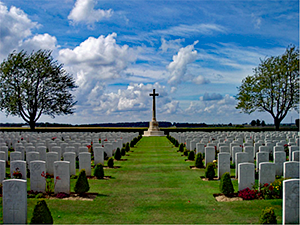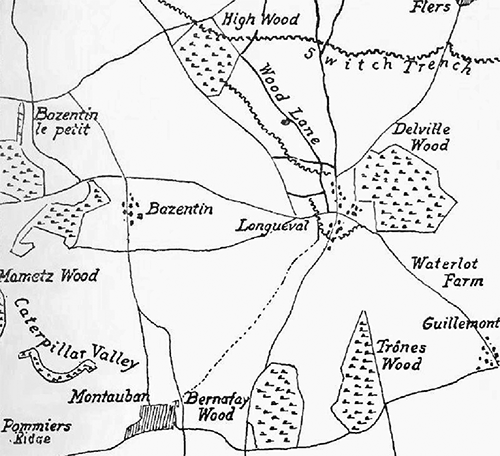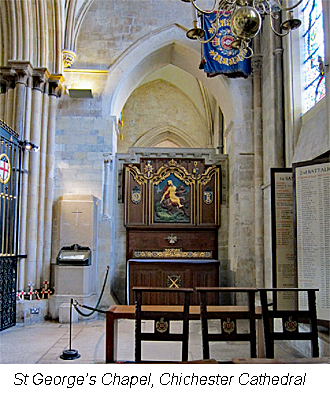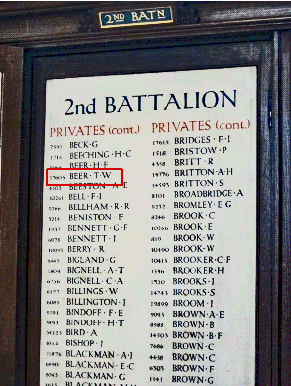First World War Project
Thomas William BEER (of Lynsted)
b. 1897 Private, Service Number 17605 |

Thomas does not appear on the Lynsted Memorial even though, at the time of his death, his parents were living at Homestall Cottages, then in the Parish of Lynsted. Apart from being named on the memorial roll in the regimental chapel of the Royal Sussex Regiment in Chichester Cathedral, he appears on no local war memorials, possibly due to his parent's peripatetic lifestyle. The Society felt it appropriate to commemorate his loss.
The seventh of the nine children of Frederick and Ellen Jane (née Williams), Thomas was born on the 3 April 1897 in Swalecliffe, Kent and christened on 9 May that year in the Church of St John the Baptist. His six elder siblings were James Robert, Ellen, Frederick, Frank, George and Annie, two younger brothers, Ernest, who died in infancy, and Albert.
By the time of the 1901 Census the family were living at 3 Studds Cottages, Herne. At the time of the 1911 Census the family had moved to Pean Cottages, Pean Hill Farm, Canterbury Road, Whitstable, where his father was employed as a horseman. Some time after this the family moved to Homestall Cottages, Lynsted, with his father being employed at Homestall Farm.
Sadly, Thomas's service papers are unavailable, but we do know that he enlisted firstly into the East Kent Yeomanry in Canterbury and was at some time transferred to 2nd Battalion of the Royal Sussex Regiment. He would serve for less than a year.
We know that the 2nd Battalion Royal Sussex Regiment arrived in France in 1914 and during that year fought at the Battle of Mons, the subsequent retreat, the Battles of the Marne, the Battle of the Aisne and the First Battle of Ypres. In 1915, the battalion fought at the Battle of Aubers Ridge and the Battle of Loos. In 1916, the battalion moved to the Somme and fought in the Battles of Albert, Bazentin and Pozierres.
In the days preceding Thomas's death, his Battalion's war diary records their position and role in the battle for High Wood:
| 1st September: Right of High Wood |
Enemy's artillery was very active and our trenches were shelled again during the morning. Our heavies shelled a sap-head held by the Germans, and several of the enemy who were occupying shell holes in the vicinity of the sap, were sniped by our men whilst attempting to fall back on their trench over the ridge. In the evening the enemy shelled our Front, Support & Reserve lines. "B" Company (Support) relieved "A" Company in the front line; although very few casualties had taken place, "A" Company had had a very trying time, the front line trench was filled in several places and a number of men buried. The following officers joined the Battalion:- Lieut Wigston G.H. (E. Surrey Regiment), 2/Lt Brading N.B. (E. Surrey Regiment), 2/Lt Alexander J.R., 2/Lt Clarke B., 2/Lt Clarke C.T., 2/Lt Weber-Brown A.M., 2/Lt Collins C.A., 2/Lt Reade C., 2/Lt Burdett J.T., 2/Lt Coleman H.E., 2/Lt Forder C.F., 2/Lt West F.A., 2/Lt Humphreys W.G. |
| 2 September: High Wood to Becourt Wood |
Situation was quiet during the morning. Our artillery opened a bombardment at 2pm which lasted till 5pm, to draw the enemy fire, whilst an attack was carried out on our right by the 50th Division. The Germans replied with heavies on our lines; once again we were fortunate in suffering few casualties in spite of the deadly accurate German fire; the trenches were filled in a good many places. In the evening we were relieved by the 1st Cameron Highlanders and came back in Reserve at BECOURT WOOD. Casualties for this period in the trenches:- Killed 3, Wounded 32, Missing 3. Capt. W.H.W. Apperley joined the Battalion as second in Command & 2/Lt Fewbrell A.H.H. as Transport Officer. |
| 3 September: Becourt Wood | Battalion bivouacked in BECOURT WOOD. Cleaning up etc. |
| 4 September: Becourt Wood | Working party of 2 officer and 250 men was found by Battalion, for burying cable in MAMETZ WOOD. Draft of 328 other ranks joined the Battalion. |
| 5 September: Becourt Wood to Lozenge Wood | In the afternoon the Battalion moved up into Brigade Support in LOZENGE WOOD and bivouacked there; the situation was normal. Draft of 9 other ranks joined the Battalion. |
| 6 September: Lozenge Wood | Battalion remained in the vicinity of the wood all day. At night working parties were found for deepening and widening the trenches near HIGH WOOD. |
| 7 September: Lozenge Wood to High Wood (Right) | At about 3pm the Battalion moved up to the trenches on the right of HIGH WOOD and relieved the 2nd Welsh in the firing line. Situation was then quiet. |
| 8 September: High Wood (Right) | During the early morning the enemy shelled our trenches heavily and we suffered several casualties, the trench being filled in places. Casualties this day:- Killed 5; Wounded 15. In the evening carrying parties were found to carry ammunition and bombs to front line for the next day's attack. |
| 9 September: High Wood (Right) | Draft of 4 other ranks joined the Battalion. The 3rd Brigade was relieved in the morning by the 2nd Brigade and the 10th Glosters (1st Brigade) came up from BECOURT WOOD in Support. The Germans were very active all day with their artillery. Orders were received that the 2nd Brigade with one Battalion each of the 1st and 3rd Brigades would attack and capture the German trench in HIGH WOOD and to the east. At 4.45pm, in conjunction with the 1st Northamptons on our left and the 2nd KR.R.C. on our right, the Battalion advanced to the attack our objective being a portion of the trench WOOD LANE. In spite of very heavy artillery and Machine Gun fire, the attacking line which consisted of "C" and "D" Companies, advanced steadily and in splendid order, closely followed by "A" Company, which was to form an outpost line in front, and "B" Company which was to consolidate "D" Company secured the objective with few losses. "C" Company on the left was less fortunate, suffering rather heavily from Machine Gun fire from HIGH WOOD. It entered the enemy trench, however with little difficulty. "A" Company pushed through and advanced some distance in front of the captured line, accounting for several of the enemy who had run back. On our right the 60th Rifles gained their objective, but the Northamptons on our left were driven back by an intense fire. This left our flank exposed and a defensive flank was dug connecting the captured line with their original front line. By dark consolidation was well under way. Several prisoners were captured and one Maxim Gun which was secured by the Battalion Scout Sergeant. Our casualties were as follows:- Officers: Killed: 2/Lt Forder C.F. and Capt. D'A Harvey, 2/Lt G.L.Reade, 2/Lt W.G. Humphreys, 2/Lt J.T. Clarke, 2/Lt G.H.E. Coleman. Wounded: Captain F.C. Sainton,, 2/Lt C.A. Collins, Capt. H. Wigston, 2/Lt Weber-Brown. Other Ranks: 43 killed [records now show that 93 other ranks died on this day] , 146 wounded, 59 missing, 4 wounded and missing. |

Action on the 9th of September had started disappointingly, when exploding of a mine on the eastern corner of the wood failed to prevent a German attack. The crater was 140 feet across and 35 feet deep and remains, to this day, as a duck pond. Along with 2nd Battalion King's Royal Rifle Corps, Thomas's Battalion succeeded in securing their gains by digging in and forming a connection with the line in High Wood itself.
The battle for High Wood lasted for 64 days, beginning on the 14 July lasting until 12 September 1916, just 3 days after Thomas's death. It was the longest single battle of the war and given several different names including "The rottenest place on the Western Front" and "The Hell of High Wood".
High Wood, despite still being regularly shelled, was never retaken by the Germans. It is thought that the bodies of around 10,000 British and Germans soldiers still lie in there.
We know that Thomas served for less than a year. It is unclear how long he served overseas. Legally he would have only served for around 5 months, but it is clear that many lied about their age to sail for France.
His name also appears on the memorial wall in St George's Chapel, Chichester Cathedral, the memorial chapel of the Royal Sussex Regiment, along with all those of the regiment that died in the First World War.


Thomas was posthumously awarded the British War and Victory medals. [See Appendix 1]
In April 1917 , Thomas's mother received his owed pay of £3 7s 2d (£3.36p). In September 1919, she also received his War Gratuity that amounted to £3. [See Appendix 2] Taken together these amount to roughly £320 in today's money.

 World War 1 Pages
World War 1 Pages